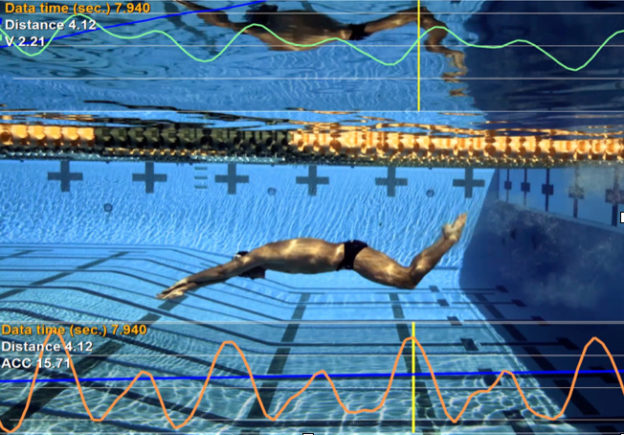Where does the kick propulsion come from?
Last week we wrote about where the pulling propulsion is greatest, so it is only fitting that we discuss the kicking propulsion this week. Believe or not, there are still coaches out there who think that the kick generates no propulsion at all, particularly while swimming. Balderdash!
The kick generates propulsion in nearly every swimmer (I have coached a few triathletes who did not move one inch down the pool with great kicking effort). Within a single kicking cycle in freestyle or dolphin kick, there are actually four different points where the feet and legs can generate propulsion:
- At the initiation of the down kick
- As the feet move down through the body’s vortex
- At the initiation of the up kick
- As the soles of the feet and back of the legs move upward through the body’s vortex.
On the down kick, virtually all of the propulsion is generated by the tops of the feet. On the up kick, both the soles or bottoms of the feet and the back of the legs generate propulsion. The amount of propulsion is related to the surface area pushing through or against the vortices and how fast it pushes through or against them. Ankle plantar flexibility is essential on the down kick, as it helps create more surface area on the way down. In this week’s Race Club video release, we show you how to increase your ankle plantar flexibility and leg strength.
In all four points of potential propulsion, the feet and legs are playing off or against the two vortices caused by the swimmer’s body and the moving feet and legs. Unlike the hands, the feet move upward, forward and downward, but not backward. Thanks to the vortices causing streams of water, the feet don’t have to move backward to generate propulsion. The hands are moving through still water and must move backward to generate propulsion. The flow dynamics are very different in front of and behind the swimmer, and so is the way in which propulsion is generated by the hands and feet.
In nearly every swimmer who is face down, the propulsion generated from the down kick is greater than it is from the up kick. In some swimmers, the greater propulsion occurs at the initiation of the down kick, as the feet reverse direction quickly and kick down against the foot vortex. In other swimmers, the propulsion generated is greater as the feet move downward through the slipstream.
Elite backstroker Luca Spinazolla generates his greatest propulsion at the initiation of his down kick (orange graph below at yellow line)
Elite backstroker Josh Zuchowski generates his greatest propulsion as his feet pass through the body vortex (orange graph below at yellow line)
While the speed of the feet and legs moving through the vortices depends on a swimmer’s strength, it also depends on the amount of effort being placed in that motion. Most swimmers put much more effort into their down kicks than into their up kicks. For this reason, I refer to the up kick as the poor neglected step-child of swimming. Yet, I have seen in some swimmers gain as much as .9 m/sec in velocity purely from the up kick, just by working it hard.
Even though a swimmer may generate propulsion from the kick in four different places in the cycle, that does not necessarily mean that the swimmer speeds up or accelerates in all four places. To accelerate, the propulsion must be greater than the drag forces. That often does not occur. Using Velocity Meter technology, we usually find only the fastest kickers will accelerate in all four points of kicking propulsion.
It takes years to develop a strong freestyle or dolphin kick, but it all starts with plantar flexibility. Without that, there is no chance of becoming a fast kicker.
Yours in Swimming,
Gary Sr.

